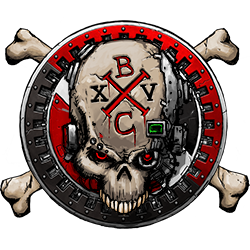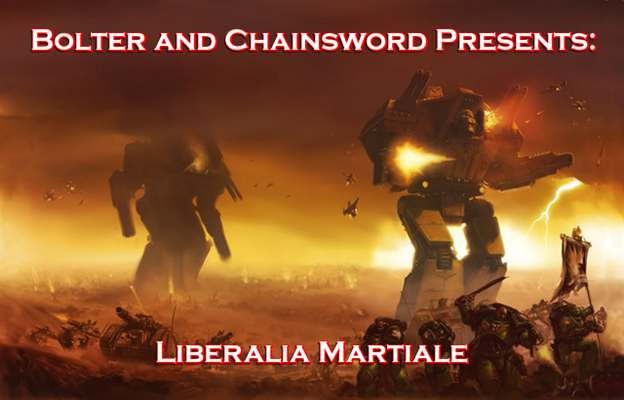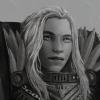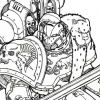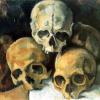Search the Community
Showing results for tags 'Iron Gauntlet'.
-
Hail, Frater! Today, on the Liberalia Martiale, The IRON GAUNTLET has returned once more! Those of you who have been around the board for several years perhaps remember the last Iron Gauntlet, last run in 2020, and then before in 2017. Those of you who have joined after 2020 may not know the name--but I assure you, you will in time! The Iron Gauntlet is the Liber's Premiere DIY event--a year-long challenge, composed of five smaller challenges, each with three tiers designed to challenge fraters' creativity to the utmost. I invite all of you to visit the Liber, and consider its rigors, and perhaps take up the challenges, to prove yourselves worthy of the Iron Gauntlet! Now, if you'll excuse me, I've got to go searching through the Deepest Darkest Depths of the Liber, and see where the accursed relic has got off to this time. Perhaps the kitchens, I don't think they've been searched (or cleaned) for years....
-
- Iron Gauntlet
- Iron Gauntlet 2024
-
(and 2 more)
Tagged with:
-
Once more, there was a rumbling in the fortress. What was rumbling, few could identify. It was not anything tangible to be felt, and produced no noise to be heard, even to the genehanced ear of an Astartes, or one of the many xenos species that maintained something akin to an embassy. No, it was not a rumbling that any scientist would call such, nothing seismic or mechanical. It was a call, however, and those that needed to hear it, did. A psychic summons, from the Deepest, Darkest Depths of the Liber. And it would be terrible to behold. =][= Hail brothers and sisters of the Liber! Once again the Liberalia has come around and we have ourselves the honour of being the centre of attention. Regardless, I would like to ask both Liberites and other members of B&C to dust off any old DIYs they have and give them another shot. Now's the time to crank out the old creativity. The IRON GAUNTLET returns! After four years gone, it returns once more- with thanks to @Olis for running it back in 2017, and @Dosjetkafor the 2020 running of the Gauntlet, - and a welcome sight it is. Now, of course, just entering is not enough! There is an expectation that we will have members who will accomplish all five challenges. If the old Iron Gauntlets are anything to go by, they will number few indeed! But, certainly, those who push themselves and achieve all that is asked of them, then they shall be rewarded with a specific and unique badge. But do not be daunted. This is supposed to be fun... in a roundabout way. If you think you can only complete specific challenges, then only enter those ones. There is nothing here saying that you must complete them all or automatically fail. Do what you can. Just remember the idea is to push yourself. To register for this Challenge or any others make the following statement: I, <your name>, of the <Chapter/Warband/Regiment/Klan/Craftworld/Sept/Legio/Gang/other organization name> take up your Challenges. I vow, before my brothers and sisters of the B&C to complete Challenge <challenge number> and submit it to the Liber before the deadline. I vow to support my fellow challengers to the best of my ability. May the Emperor/the Dark Gods/Gork and Mork/Hive Mind/other 40k deity/Brother Argos curse me if I fail. [Please leave a link to your article so I can update the first post.] The Challenges: Challenge the First * Bronze: Complete a 1,000+ word article describing the origins and history of your organization and post constructive criticism in other DIY threads; * Silver: Complete a 2,000+ word article describing the origins and history of your organization and post constructive criticism in other DIY threads; * Gold: Complete a 3,000+ word article describing the origins and history of your organization and post constructive criticism in other DIY threads. -> Duration: 17th March – 17th May (2 months) Note: The format of your article is not strictly relevant, though it is encouraged to follow the usual DIY guidelines. (If you're not familiar with the article types, check out @Brother Tyler's article template thread linked here. I also encourage you to check out the rest of Liber Resources if you're stuck for ideas and/or looking for some solid advice from renowned Liberites of old.) Challenge the Second * Bronze: Fully assemble, paint and base a Kill Team (at minimum: three models) representing your organization; * Silver: Fully assemble, paint, and base a Combat Patrol (at minimum: one CHARACTER, one BATTLELINE, and one additional unit) representing your organization; * Gold: Fully assemble, paint, and base a Strike Force (at minimum: one HQ, one BATTLELINE, and five additional units) representing your organization. -> Duration: with 17th May – 17th July (two months) Note: If your organization represents an Aeronautica Imperialis, Adeptus Titanicus, Blackstone Fortress (BSF), Legiones Imperialis, or Necromunda organization, use the following tiers: * Bronze: Fully assemble, paint and base a Flight (at minimum two Aeronautica aircraft), a single Titanicus Titan, a Banner (at minimum three Titanicus Knights), [LI I’m not familiar with, if you’re doing them, let me know and I’ll figure something out], half an Exploration Team (at minimum two BSF Adventurers), half a Hostile Swarm (at minimum four BSF Hostiles), OR a demi-Gang (at minimum four Necromunda Gangers); * Silver: Fully assemble, paint and base a Squadron (at minimum four Aeronautica aircraft), a demi-Maniple (at minimum two Titanicus Titans), a Lance (at minimum six Titanicus Knights), [LI I’m not familiar with, if you’re doing them, let me know and I’ll figure something out], an Exploration Team (at minimum four BSF Adventurers), a Hostile Swarm (at minimum eight BSF Hostiles), OR a Gang (at minimum eight Necromunda Gangers); * Gold: Fully assemble, paint and base a Group (at minimum six Aeronautica aircraft), a Maniple (at minimum four Titanicus Titans), a Household (at minimum nine Titanicus Knights), [LI I’m not familiar with, if you’re doing them, let me know and I’ll figure something out], a reinforced Exploration Team (at minimum six BSF Adventurers), a reinforced Hostile Swarm (at minimum twelve BSF Hostiles), OR a reinforced Gang (at minimum twelve Necromunda Gangers); Challenge the Third * Bronze: Post a battle report of a game you played with your organization force created in Challenge #2; * Silver: Post a battle report, with EITHER pre- and post-battle fluff (500 words each) OR turn-by-turn photos/maps, of a game you played with your organization force; * Gold: Post a battle report, with pre- and post-battle fluff (500 words each) AND turn-by-turn photos/maps, of a game you played with your organization force. -> 17th July to 17th August (1 month) The Penultimate Challenge * Bronze: Create a dataslate (converted and painted model, fluff, custom rules and stats) representing a notable character from your organization; * Silver: Create two dataslates representing two notable characters from your organization; * Gold: Create three dataslates representing three notable characters from your organization. -> Duration: 17th August to 17th September (1 month) The Final Challenge * Bronze: Write a story about your organization that is between 1000 and 1999 words in length; * Silver: Write a story that is between 2000 and 2999 words in length; * Gold: Write a story that is 3000+ words in length. -> Duration: 17th September to 17th December (3 months) And finally, I'd like to wish you all the best of luck for the upcoming challenges! Remember to push back the boundaries of what you thought you could achieve and, most importantly, have fun! P.S. If you have an issue or question and you haven't gotten a reply in a couple of days from one of the Mods, feel free to send a PM to the Moderators on the list below (make sure to include them all in the PM so whoever sees it first can answer): @Brother Cambrius @Daimyo-Phaeron Lenoch @Kelborn @Lysimachus A note on organization: Fraters’ vow posts will be linked in the main post Fraters’ vow posts are asked to have links to each of their threads elsefora, through the entire challenge This is to help the organizer keep track of who’s doing what challenge, etc Threads for the other challenges will be linked in the main post Frater are also asked to tag their threads with 'Iron Gauntlet 2024' for sorting/ease of searchbar use Best of luck to any and all who choose to participate! I look forward to seeing your DIYs! Participants: @ThePenitentOne : The Sisters of Saint Katherine's Aegis @NovemberIX : Knight House Garaipeña @twopounder : The Obsidian Angels @Lord Abaia : The Sulphurborn @sitnam : The Bluebeak Kindred @Trokair : 7th Rhûnish Dragoons @Rusted Boltgun : The Fists of Light @Brother Argent : Interdictors
- 106 replies
-
- Liberalia Martiale
- Liberalia Martiale 2024
- (and 2 more)
-
Three of the characters of my DIY chapter. Sadly I have noone to try out the rules, so no points for them at the moment.
-
The game was a narrative one for my Astartes Chapter, therefore I had 1500 points while the Tyranids had only 1250, but the swarmlord had double the AoE of the hivemind than normal. Also the Lictor spawned only a charge away from the main bulk of the tactical Marines. This is my first battlereport so feel free to criticize me The victory condition was to either kill the Contemptor Dreadnought or the Swarmlord. “I have to go! They need me!” The metallic voice of brother Perseides echoed through the chamber. “Brother Bartel, you are not old enough to understand that! If I don´t join the fight today our enemy will crush us!” The Techmarine raised an eyebrow. “Brother. I know, I am not as ….. experienced as you, but I am an Astartes since five-thousand years. My duty is to keep you and your dreadnought-body alive.” “And I am bloody well, so. Let. Me. Go!” Even without the sarcophagus-attached monitors Bartel knew Perseides was angry. “In which chassis? Your plasmagun exploded, your stormbolter is jammed and one of your legs is still missing on the battlefield. If I install you in the chassis, what would you do? Crawl to the enemy?” “If I have to!” Brother Bartel sighed deeply. For a short time the chamber was quiet, just humming of the live support systems in the background. Brother Perseides broke the silence,”what´s with the old one?” “You are joking right? We don´t use it because the machine spirit is at least as stubborn as you, maybe even more. It rejected ever brother since nearly eight-thousand years.” “Now who is joking? Nobody is as stubborn as me! Give me that body!” “You know what? Maybe you are right on that part.” Hydraulics screeched and sirens howled as the Sarcophagus entered the old contemptor-chassis. The machine-spirit didn´t liked getting woken up and clearly it didn´t liked to get a new pilot. The Techmarine and his serfs needed more than an hour to install the Sarcophagus and half an hour to calm down the machine-spirit. With heavy steps the contemptor-dreadnought stomped out of his chamber. Sergeant Irius gave a questioning look to Bartel. “I go readying my squad, right?” Bartel looked back and sighed. “Yeah. Let´s go with him.” On the planets surface, Company-Sergeant Ariast was on his way to the imperial outpost command. It was only a matter of hours before his Marines gain victory over the besieged tyranids in the nameless city left of him and he wanted to inform the PDF about it. He looked to the dull sky for no real reason as he sees tyranidspores hitting a black dot in the sky. Something exploded and the dot went down. As the dot closed on him he recognised the object and opened all channels of his intercom. “Brothers! Ready yourselves for impact! A Thunderhawk is coming down near us!” Like one man all Astartes crouched. The Thunderhawk sailed over their heads and a shockwave went through the ground as the flyer crash-landed. Ariast looked up to and saw a dreadnought fighting his way through the ruined aircraft, making the most direct way to the besieged city, followed by some Astartes and an Techmarine. He scanned along the way the flyer took, to see if it missed the command bunker. The Thunderhawk did but the Tyranids not. As he sighted the bunker, the last member of the PDF command was slaugthered by a Lictor. Just seconds later the whole city roared as the stalemated xenos started their last attack on the Space Marines. Deployment: Turn one: The right flank went very well for the Marines. They killed the Lictor with ease and five Gargoyles too and the rest of them were killed in close combat. Also the Haruspex lost some wounds. On the left flank the assault Marines tried to interruped the coming Hormagaunt but fall short. The Gaunts ran past them and charged squad Irius, killing two of them. The Toxicrene shot at the assault Marines and fragged/eated seven of them. Turn two: The left flank was victorious again. the combat squad attacked the Ripper swarms, stomping some of them to the ground. The Centurions charged the Haruspex, eviscerate it completely while only using one brother. The Carnifex charged the Centurions and managed to nearly kill one but therefore gets destroyed. The right flank was a massacre. While the Gaunts died they managed to destroy five more Marines and the surviving six were removed by a fierce attack of the Toxicrene. Three Raverners came out of the ground behind Perseides but gets nearly completely eliminated by the contemptor. Turn three: The third round made the game clear. The last ravener died, as well as the Toxicrene. The Termagaunts with the fleshborers soaked most of the fire and only one remained on the battlefield. The Tyranids solemny managed to do some damage but nothing serious. Last turn: the combined fire of the Marines destroyed every gaunt on the table. only the swarmlord managed to survive with nothing but scratches. We let both of the victory conditions fighting against each other. The swarmlord was very unlucky, not even able to do a single wound. Perseides saw his chance, grabbed the head of the monster and ended its life. It took some time for the dust to settle. The stalemated Tyranids were killed but so were many Astartes. The Apothecarii ran around caring for their wounded brothers and Techpriests maintained the damaged systems, tanks and fortifications. Company-Sergeant went through the trenches towards the Techmarine and the dreadnought who fell down with the Thunderhawk. They stopped talking as Ariast came closer. “Don´t get me wrong brothers, but who told you it was a good idea to deploy that close to a siege?”, asked Ariast. “I am sincerely sorry sir, but we had to test the...”new” chassis for our honoured brother Perseides, in battle conditions. We couldn´t afford to land far away, we don´t know the influence of the contemptor to our brother yet.” The Company-Sergeant let his view sweep around both of them. “When you are finished with Brother Perseides I would appreciate it, that you help us with the equipment and machinery, Bartel.” “Of course, it won´t take long.” As Ariast went away, Perseides glanced down to the Techmarine. “You could have said him, that it was my fault. I was stubborn and now many of our brothers are dead. I wouldn´t have judged you for that. I would have understand that.” “But would have helped that anyone? I guess as long as your brain is not completely rotten in this Sarcophagus of yours you will not do something THAT stupid again. Also, these monsters you crushed may have killed even more of us.” “Nonetheless thank you for that and rest assured I grieve the dead of squad Irius and will give my best to redeem my failure.” “I ho-” Bartel was interrupted by the sound of a chainsword cutting through flesh only metres away of them. They saw the tip of it burst out of the stomach of the Toxicrene. A hand was pushed through the newly made slash, searching for a hold on the ground. Perseides was there first and teared out a big chunk of xeno meat and revealed an assault marine. Bartel helped him on his feet. “It´s okay! Help them! There are at least seven inside, not digested yet!” While working on the dead body of the Toxicrene, Bartel activated the intercomm,”Techmarine Bartel here! Need urgent medical support on the Toxicrene corpse!” In the end nine brothers were rescued from the cadaver, one of them was sergeant Irius. Perseides visited them as often as possible, pledging vows of redemption and revenge as well as promising to help them on the battlefield. After this victory the Astartes of the Genocide Angels were deployed elsewhere on the planet. While the Tyranids have to compute the huge losses dealt to them the nurglish menace in the Worgost hive grew stronger every hour. While the Space Marine force departed a figure in a shadow observed them. After the last of the Astartes went into the transport, it took out a communication device. “Inquisitor. Unknown Adeptus Astartes Chapter now on the way to Worgost. Until receiving new orders I will make my way to the hive city.”
-
The New Eden Rifles Renowned for their stoic steadfast nature and their stubborn refusal to accept defeat the New Eden Rifles have gained a name across the length of the Imperium as all but unbreakable in defence and just as determined in assault. The New Eden Rifles regiments combine a defiant nature with a plucky and almost irreverent attitude to war and their enemies that has, on occasion, caused their allies to question their reliability on the field of battle but once battle is joined they quickly change their minds. The New Eden regiments are siege masters without equal in the Sub-Sector Incogni meeting their enemies with unbroken trench works and shelling them relentlessly from artillery batteries. Regimental History The planet that would become known as New Eden was discovered in the later days of the Great Crusade. Noted for its virgin arable lands and harsh but beautiful landscape its was inhabited by a primitive hunter gatherer nomads whose technology was equivalent to ancient Terran Stone Age. It was quickly earmarked for settlement and before long settlers arrived from across the vast expanse of space. Its lands were perfect for farming and soon the surface was dotted by vast sprawling farming estates ruled over by wealthy nobles whose lands were worked in turn by criminals, slaves and indentured freemen supplemented by those natives of the planet whom had been deemed useful for integration with the Imperium at large. Qualified overseers and tradesmen arrived from across the breadth of humanities worlds to help supply the farm workers and soon New Eden was a flourishing Agri World supplying foodstuffs across much of Sub-Sector Incogni and further afield. It was not to last however and in the closing days of M.39 the region of space that Sub Sector Incogni bordered on, known as the Bleak Stars, became a hot bed of activity for the xeno species known as the Orks. A lawless region that had escaped the reach of the Emperor’s Great Crusade it easily was subdued by the by the beastial xenos and soon they would push into Imperial help space. Faced with Xeno invasions across multiple Sub-Sectors, including Incognil, the Imperial High Command was unable to meet every push against the xenos and in the vast bloated bureaucracy of the Imperium Incogni and New Eden were either forgotten or deemed unimportant and resources were sent elsewhere. As orkoid vessels pushed into the sector what little Imperial forces that were their were quickly brushed aside. Deciding to cut their losses and regroup on one of the newly established fortress worlds Sub Sector Incogni was declared a loss and the Imperium turned its back on those whom still dwelt there. Declared lost by the Imperium the world of New Eden was far from fallen. Its PDF stood defiant against the off-world xenos. Defences were quickly set up and soon New Eden’s farmlands were divided by sprawling trench works and make-shift bunkers. The planets defenders prepared to sell their lives dearly and it wasn’t long before the Orks arrived on-world. Expecting to find frightened farmers and flimsy defences, like they had on the rest of the Imperium’s worlds so far, the orks were instead surprised to find stoic lines of defenders in their path. Their would be no easy victory on New Eden. Steadfast defiance and unbreakable determination met bestial and unthinking rage and it wasn’t long before New Eden’s verdant fields were turned into a bloody quagmire of blasted apart corpses, both xeno and human, and craters bloomed across the ground like pox marks. But the orks are a race bred for war, they thrive on it, and whilst the ork numbers seemed exhaustible the PDFs were not. Despite their intractable defence their numbers began to dwindle and so the Planetary Governor issued a decree, known forever after as simply “The Emperor’s Call”. A lotto would be taken with every citizen of New Eden, from the lowest criminal slave labourer to the Planetary Governor himself, entered. A day of the year would be drawn at random and every person born on New Eden on that day would be drafted into service in the PDF. It was an initiative the Governor would prove himself committed to when his only child, a daughter, was taken in the first Call. His position was simple, New Eden would stand even if he had to spend every last drop of blood on the planet to do so. When Imperial Forces eventually pushed the orks back in the early days of M.40 they expected to arrive in Incogni to find destroyed worlds overrun by greenskins. Instead they found New Eden still standing, her once verdant fields covered in vast elaborate trench works and defensive positions that ran like spider webs across every clear surface. And when the trench works had fallen the men and women of New Eden had fought for every inch of their cities. Roads were choked with razor wine and make-shift tank traps. Machines and animals, once used to tend to farms or clear land had been turned to war. Weed spraying trucks had been outfitted into crude flame thrower tanks and plows had been reforged into dozer blades. Despite being abandoned for as long as it had New Eden still held on defiant. The newly arrived Imperial crusade quickly helped the New Eden inhabitants reclaim their planet. As the last orkoid was burned in righteous fire Lord Commander Ferius, commander of the Imperial Crusade, commented on that is was as If by the Emperor’s divine providence itself that the world had held. He promised them whatever aid they needed to restore New Eden to its former glory, a gift for their loyalty, when the orks were pushed back to the Bleak. It was a surprise to him when the commander of the planets defenders, the former Planetary Governor whom himself had been taken in the thirteenth Call, declared that he and his men would come with them to see the orks driven from the Imperium for good. Thus was the 1st New Eden Rifles formed. Lord Commander Ferius was good to his word and ensured aid to the planet following the defeat of the orks and it wasn’t long before New Eden was recovering. Crater’s were turned to water supplies and the trenches were kept, a reminder of the regiments proud past. It wouldn’t be long before they would be used again, however, with the orks of the Bleak rising again and again to threaten the Imperium throughout the new few Millennium. Notable Campaigns Pilium Crusade (M.39) The newly founded 1st New Eden Rifles accompany Lord Commander Ferius on his next crusade following his success against the orks, along with many other regiments and no less then two companies of the Space Marines against the traitor forces near the warp storm known as the Pilium Anomaly. Despite great success contact against the enemy eventually the contact is lost with the forces after they enter the Anomaly itself and eventually they crusade is considered lost. Fall of Gokh (M.39) The 22nd New Eden Rifles form part of the Imperial Forces besieging the seccesionist forces on the world of Gokh. Despite horrendous casualties on both side, including losses due to the employing of Phosphex artillery by the planets defenders the Imperial forces are victorious and the Secessionists are put to the sword. The Battle of Bridge 432 (M.40) Assisting the forces of the Iron Heralds Astartes Chapter elements of the 34th and 22nd New Eden Rifles help hold of a previously unknown Xeno species known as the Desmerax. The turning point of the battle comes when the Rifles hold the Bridge, designation 432, against countless waves of xenos before the Heralds can eliminate the xeno leaders, breaking their forces and sending them back into the Bleak. The Second Battle for New Eden (M.40) Although it has come under constant assault over the years from orks as well as other xeno races the second major invasion of New Eden came in the later part of M.40 when a vast force of Traitor Astartes sworn to the Blood God, Khorne, invaded. The New Eden Rifles would stand firm as always and the waves of frothing madmen were met with ranks of sustained fire and constant artillery bombardment. The invasion would be broken and the planet held, but not before extensive damage was caused again to the planets farming again. The Charge of the 1st New Eden Light Horse Brigade (M.41) On the desert world of Al-Ermain Imperial Forces had been fought to a long standing stale mate against traitor forces. Facing impressive trench works and bristling gun emplacements the forces of the Guard were unable to push any further forwards without sustaining heavy casualties. Several sorties from the infantry and tank brigades had simply caused substantial losses on the Imperial forces without gaining any true ground. Knowing that a victory here was essential to capturing the world Captain Johanne Winters of the 1st New Eden Light Horse Brigade ordered his men charge straight into the gun lines. Seen as a suicidal assault Johanne was determined his men would break the enemies lines. It was a ploy that worked when surprised by this seemingly mad man and his men’s charge the traitors guard fled their positions or surrendered in a panic, unsure how else to react. With the gun lines broken with minimal casualties the Imperial forces went on to secure victory and Johanne was awarded the Star of Terra, one of only two Guardsmen of New Eden to ever receive the award. The Black WAAAAAGH!!! (M.41) Ork Warboss Drizog Blacktoof leads a vast orkish invasion from the Bleak into Sub-Sector Megara, sector of the Iron Heralds homeworld and neighbouring sub sector to Incogni. No less then seven combined regiments of the New Eden Rifles, including the 13th New Eden Rifles led by the heroic Colonel Katrin Pendt and the 1st New Eden Light Horse, still led by the unflappable Johanne, are deployed to help the Iron Heralds defend their homeworld. Joined by forces from throughout the Sub-Sectors the Orks are eventually defeated when Drizog is slain by Chapter Master Seric in single combat. Colonel Katrin is awarded a relic bolter by the Chapter Master due to her part in the defence on the Pelion Fields. Homeworld Its vast farmlands tended by criminals, slaves and indentured common folk New Eden is somewhat of a melting pot of cultures from across the immediate area of the Imperium. This peculiar blend of different cultures had strangely bred a strong bond between the planets inhabitants. It is a camaraderie that serves them well both in the fields as when as on the battle fields. Although officially an Agri World New Eden has started to bare many similarities to a Fortress World. With the ever present orkoid threat in the Bleak Stars as well as the fact that the Imperium never truly recovered from the losses from the first orkish invasion means that New Eden is frequently assaulted by disparate ork warbands, although nothing on full WAAAAGH!!! status. The New Eden PDF is well drilled and experienced, working to maintain the vast trench networks and gun emplacements that have become as much a part of New Eden’s landscape as its sweeping farmlands. Most native born New Edene, as they are called, end up working on the planets farms as either overseers or qualified craftsmen of some sort on the farms or in one of the three major hive settlements on the city that have grown around the planets space ports. These hubs are a vast market of sorts with food stuffs and other farmed goods being exported across much of the nearby Imperium and all sorts of criminals and farm machinery arriving daily to feed the labour needs of the vast farming estates. Recruitment There are two ways one can end up in service in the Guard on New Eden. The first is service within the planets PDF and is typically a voluntary commission. Any and all, from lowest criminal to highest noble, are welcome to swear their lives to the service in the PDF and if they do so they are trained and equipped to defend their homeworld and can expect to spend the rest of their lives in the trenches of New Eden, either keeping them repaired or fighting in them. The other way is through the Emperor’s Call. A practice established in the early defence of the planet it has been kept as a standard practice to help meet the Imperial Tithe alongside the planets food output. Much like the first Calls a date will be drawn at random and any and all those born on that day must report to their local recruitment centre where they will be deemed fit for service or otherwise. Even those unfit for direct service will often find themselves drafted for service into the regiments support crews. These recruits are then stationed with the PDF for a short while to receive basic training and equipment before being sent off world in service to the Emperor. It is this way that the New Eden Rifles Regiments are usually split equally amongst men and women and recruits will range from criminals and poor labourers to the highest ranking nobles. All are equal once they answer the call however and the regiments original officers are drawn from PDF where their service and experience has given them the skills needed to lead the newly founded regiment. It is not uncommon for ab-humans to be sent to New Eden for service on the various farms. Each have their own uses in the vast Agri complexes and these services can serve equally well in the Guard. Because of this they aren’t exempt from the Call, just like any and all on the planet. Regiment Organisation Regiments from New Eden are typically divided into separate core formations depending upon their previous skills and employment. The most common of these are the regiments of ‘Rifles’. These tend to follow the standard size and layout as prescribed in the Tactica Imperialis. It is these regiments that most think of when they think of the regiments of New Eden. Implacable in defence and attack they have a down to business attitude matched with an almost irreverent attitude towards war and their enemy that mas many doubt their effectiveness until they see them in battle. New Edene have a strong sense of camaraderie that will often see them going to great lengths to save a wounded comrade. It is this combined with their never say die attitude that has seen them stand defiant when many other regiments have fallen. Other forms of regiments drawn from New Eden often relate to specialisations that the drafted soldiers had before their Call. Regiments such as the ‘Light Horse’ regiments formed of those herdsmen whose job was to ride animals similar to the now extinct horses of ancient Terra to shepherd the vast herds of farm animals on New Eden as they make their way across the landscape. Others are formed from the farm vehicle operators drafted into ‘Armour’ or ‘Artillery’ regiments depending on the needs at the time. It isn’t uncommon for New Eden Regiments to serve alongside each other in warzones where Imperial Commanders just refer to them as ‘New Eden Rifles’, but not in front of the soldiers themselves whom seem to have developed a friendly competitiveness between regiment types. Regiment Wargear The standard New Eden Trooper is equipped as follows: 1x M36 Lasgun: The standard work horse of the Astra Militarum the M36 is one of the most common patterns of lasgun in the Imperium at large. All guardsmen receive one upon being inducted to the guard. It has been commented that a lasgun is far more valuable to the Imperium then the man whom hold it, a saying that the New Edene regiments take objection too. It is from this weapon that the New Eden Rifles get their name. 4x Charge packs: Standard ammunition pack for most imperium las weaponry. Can be recharged crudely by throwing into a camp fire. This does reduce the life of the charge pack however. A fair trade off as far as the New Eden Rifles are concerned, not that they would admit this in front of the Commissariat. 2x Frag Grenades: Standard Imperial Issue fragmentation grenades 2x Krak Grenades: Standard Imperial Issue krak grenades. 1x Auto Pistol: A favourite side arm amongst Astra Militarum forces. Issued to troopers to use as a last resort. The New Eden Rifles tend to favour them once enemies have breached their trench lines, favouring the smaller size in the close quarters. 2x Auto Pistol Magazines: Standard Imperial Issue magazines for an Auto pistol containing solid metal jacket rounds, 1x Combat Knife: Good for cutting enemies if all else fails. Or your field rations if all chewing fails. Just don't let the Brass catch you doing the later. 1x New Eden Trooper Uniform: Typically dark grey combat fatigues similar in style to the plain thick grey clothes worn by the planets farm workers. Indeed it has been noted that they may be the surplus of exactly that. They are sometimes, but rarely, changed with slight camouflage patterns depending on the warzone the trooper is fighting in. They are designed to offer protecting in even inclement weather although only to a point. 1x Flak Armour: Standard Imperial Issue flak armour, based off the design worn by Cadian Shock Troopers. Not that the New Edenes care about where it comes from as its often the only thing between them and a bloody death on some back water world of the Imperium. The helmet often has an inbuilt short range vox suite 1x Rucksack with Entrenching Gear: Masters of trench warfare most every New Eden Rifleman is provided with basic gear for entrenchment, including shovels and wire cutters. More specialised units within the regiments are provided with more gear and training for full trench construction. 1x Basic Field dressing: For very, very basic emergency first aid (Increases trooper survival by 1.5% compared to untreated wounds) 1x Sleeping Bag or Blanket: Sleeping in luxury… 1x Mess Kit, stale dry rations and two days (mostly clean) water: eating only the finest foods… 1x Dog Tags: When you need to know who that bloody mess was. 1x Rechargeable lamp pack: Basic hand held lamp pack, good for late night reading. 1x Imperial Infantryman’s Uplifting Primer: Standard issue text that covers everything from how to on gear maintenance, combat tactics, field first aid and prayers and guide to proper devotion to the God Emperor. Commissariat recommends this to to be the ONLY thing you are reading at night. Punishment for loosing or damaging this text is severe. Other more specialised regiments or troopers may be issued with: Heavy Weaponry consisting of possibly: Mortar, Heavy Bolter, Lascannon, Auto Cannon or Missile Launcher. Usually issued to two man teams due to the size and encumbrance of the weapon. Specialised Weaponry consisting of possibly: Flamer, Grenade Launcher, Plasma Gun, Sniper Las-Rifle. Depending of situational needs Medical Kit: Slightly more comprehensive kit issued to company medic for first aid in combat situations. Vox Caster: Standard communication device issued to ensure good communication in battle environments. New Eden Proto-Steed: A strange blend of bio-mechanics and nature creating a steed similar to the horses of ancient Terra. Ridden into battle by particularly fool hardy troopers. Regimental Markings New Eden regiments tend to follow a fairly standard regimental marking system, with squads being issued a unique three digit number upon enlistment. Command staff are typically issued a two digit number with a skull in the middle and more elite or specialised regiments have three digit numbers starting with a zero. Regiments are often issues with a second number, typically the date of their birth date and the reason they were called in the draft. Regardless all troopers, from the lowliest conscript to the highest ranking officer, carry the rising sun symbol of New Eden on their left shoulder pad. Notable Regiments 1st New Eden Rifles: Founded following the liberation of their homeworld from orks the 1st New Eden Rifles continued on their glorious service until they disappeared into the Pilium Anomaly along with the rest of the Crusade they were with. Only their regimental standard was ever recovered and it rests with honour on Terra in the Hall of Heroes. In honour to the first scions of New Eden the number was retired with honour. 1st New Eden Light Horse Brigade: The first founded regiment of Light Horse designation the 1st New Eden Light Horse has served faithfully since then, having fought the length and breadth of the Imperium. They have been all but wiped out on several occasions but they are always rebuilt and continue to serve faithfully. They are currently commanded by Captain Johanne Winters, a unflappable scion of New Eden’s noble houses possessed of steel nerves and unshakable courage. 13th New Eden Rifles:”Katrin’s Own”: 22nd New Eden Rifles “The Blood Hounds”: 34th New Eden Rifles: 102nd New Eden Mechanised“The Free-born” : The first regiment ever from New Eden to consist entirely of the free children of indentured criminals on New Eden it was formed specially at request of Inquisitor Stromnash to serve during the Siege of the White Spire. Following the Imperial victory they were released back into Imperial service. 255th New Eden Heavy Armour Division “The God Killers”: Notable Heroes Colonel Katrin Pendt: TBA Captain Johanne Winters TBA Lord Commissar Jon Abram TBA First Lieutenant Sharia Tothe TBA Major Luthias Brom TBA
- 8 replies
-
- Iron Gauntlet
- Brother SP
- (and 6 more)
-
Here my entry for the second challenge of the Iron Gauntlet The first pics are my characters: A Techmarine with conversion beam, made out of bits The brothers (actual brothers) made with green stuff. My first try on modeling The leader of the White Fortress detachment. Second try on modeling combined with bits My first (mostly) finished squad: My Assault Squad. I tried some new things on them like FW weathering powder and non-metalic-gold. As soon I get my hands on the GW-jewel-effect-paints I will finish this squad with it. Because I am really bad at giving names I still don´t have them for my characters. Feel free to suggest some Edit: Link to first-challenge-thread http://www.bolterandchainsword.com/topic/332574-iron-gauntlet-genocide-angels-sixth-chapter/
-
DESERTER Nothus peered over the fallen wall during a brief respite from constant autogun fire while his armor's auspex registered potential targets within the hazy mess of the keep's breach. Ducking back down again as another wave poured out from behind the ruined barricade, he readied himself for the approaching horde of poorly-equipped militia. "Vita brevis", he sighed to himself as he stood up and took aim. Chunked entrails spewed outward almost instantly as his neatly-placed shell detonated within the chest of the one of the city's still-fervent defenders. As he lept into the foray, boltgun still blazing, the violent screams surrounding him slowly coalesced to a cacophonous roar. A few ominous clicks preceded a brief moment of silence before the frag grenade cleared the smoked-filled killing field before him. + + + "The Bastard", as he is known among his fellow warriors, abandoned his oaths to the Imperium upon being captured during the Fall of Badab. His lower half was found to be all but destroyed, and he had suffered extensive melta burns from his chest to his nose, which had since been replaced with a bionic rebreather. He had chosen life when it was offered along with his surrender and personal service to technical and medical genius known "Ovis" of the enigmatic renegade Astartes group known as "The Violent Gods". Nothus Dega spat on his former allegiances quite willingly when given a chance to subvert his fate by transcending the limits of the body- a body he had finally been made to understand was as mortal as anything else made of flesh and blood. The nickname was indeed well-earned. He had recently been assigned as a squad leader while the Gods' officer ranks were thinned as part of his long journey toward induction into the group's inner circle,. Despite his considerable combat prowess, however, his primary interest was found outside the battlefield. He had not been chosen from among his class of aspirants to study the ways of the Cult Mechanicus, and the sting of failure had haunted him throughout his tenure with the Sons of Medusa. With new life had come a new sense of reverence for the mysteries of existence and a deep desire to master them. Now with the wisdom garnered from his near-death experience, he cared little for the orthodoxy of the source from which such knowledge might be acquired. The knowledge to which he now had access surpassed his wildest conceptions, and so there were no limits to what he would subject himself to in order to maintain his access to it. Though he had started off as simply a de facto heretic, he now found himself among the true believers. Achieving his masters' military objectives was his duty for the time being, however, and his own interests would simply have to wait. + + + The field in front of the wall's opening had not been cleared entirely by his grenade, and he would now have to clean up after himself. Nothus rarely said much before entering the field of battle, and even his centuries now spent fighting for the cause of the Violent Gods had not changed his old ways. Far more terrifying than any voice was his cold silence, and Nothos took a certain sort of pleasure in experiencing the simple sounds and smells of warfare without distraction. The rhythms of the dull thuds of slumping bodies accompanied a dozen final breaths as Nothus let loose a quick burst of boltgun rounds into the disorganized mob. Blood-curtling yelps threatened his trance-like advance as his fellow warriors surged forward on both sides. All the while, he squeezed his power axe tightly as he continued to let loose into the smoke-wrought carnage before him. A lone defender somehow trudged through the overwhelming firepower and set his path directly towards Nothus, who sidestepped the hail of poorly-placed autopistol fire and slashed low and wide as he stepped forward. The move left the man groaning pitifully as his legless torso dropped, intenstines flopping onto the ground in a sputtering haze of blood and bile. A familiar series of symbols flashed across Nothus' visual field as his enhanced armor confirmed the presence of the chemical he had already tasted in the city's blood-soaked air: iron, the indelible marker of human mortality. All around him the city's ragged vanguard continued their dogged advance, even if their efforts must have felt quite fruitless. Behind him, friendly lascannon fire from Ovis' detachment rained down into the breach, carving holes into the city's desperate counter-attack, including the failing walls that continued to funnel the city's defenders directly into the spearhead led by Nothus himself. The enigmatic techno-mystic, however, was absent as usual, preferring instead to keep company with his esoteric bio-mechanical research and sending his equerry to command in his stead. Nothus recalled his surrender and conversion to the cause of the Violent Goes quite vividly. Though his memories of his final battle as a sworn Medusan still remained vague, his revival on a cold operating table in Ovis' laboratory came back in exquisite detail. An acrid itch pulsed all across his chest as his visual field remained a dark void, spotted by fuzzy pockets of orange light. The image cleared to the dull outline of a dark figure hovering over him in the dimly-lit and bitter-smelling chamber. "Would you like to know why you're alive?" The bite of the metallic voice sent shivers down Nothus's spine, further exacerbating his increasingly desperate urge to pull his bound arms up to rip out whatever thing had replaced his ruined face and chest so as to stop the maddening itch. His violent thrashing calmed and he grunted pained assent as the figure paced around to the other side of the operating table. "You have an air of tenacity about you, a quality I observed in you even from across the battlefield. Should you renounce your vows to the Imperium and swear allegiance to me, I can allow you to continue on and to learn from my technically-gifted friend Ovis here the ways of machines and of the flesh in this world, and of the subtle interactions between them. On my end- I, Jaruk the Apostate, can teach you the secrets of the universe, for they are many, and our keys to our access to many of those secrets themselves lies hidden in various parts of our material domain. The Imperium has- for the entirety of its existence- endeavored to hide certain truths from us. Perhaps those motivations were for simply our preservation, or perhaps for intentions more nefarious, but nonetheless, kept from us despite the crucial role we played in its very sustenance. I suspect that you, too- particularly in your training regarding the circumstances of your chapter's birth- came to wonder if such things might be true. They are true, and you are only alive because they are true. Since the alternative is that Ovis transplants a new head onto your torso and throws your current one away, have you made your decision?" + + +
